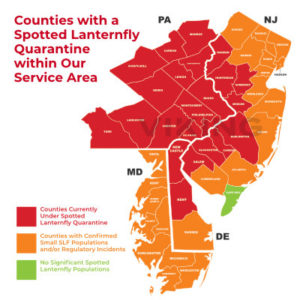Pennsylvania Spotted Lanternfly Control

The Pennsylvania Department of Agriculture identifies the spotted lanternfly as, an invasive species that has spread to several counties in the southeast portion of Pennsylvania. This pest is native to Southeast Asia and was first identified in Pennsylvania in 2014. In Pennsylvania, the spotted lanternfly population is growing quickly and has the potential to be a real threat to homeowners, business owners, and both the agriculture and forestry industries. To protect your Pennsylvania home or business from spotted lanternflies, you need to learn about the behavior of this pest, take steps for prevention, and find effective treatment options should an infestation occur.
Counties in Pennsylvania with a Spotted Lanternfly Quarantine

What Are Spotted Lanternflies?
The spotted lanternfly is a destructive insect that feeds off several different types of vegetation, such as fruit trees, grapevines, hops, and hardwoods. Large populations of spotted lanternflies can do serious damage to residential vegetation and crops. The Pennsylvania pest control experts at Viking Pest explain when spotted lanternflies eat, they expel a substance known as honeydew, which can lead to black soot-like mold on trees, attract other types of pests, and cover outside furniture and play equipment. The spotted lanternfly is reproducing quickly in Pennsylvania and posing an ever-increasing threat to the well-being of the vegetation in the state and the quality of life of residents.
How to Identify Spotted Lanternflies
The Pennsylvania pest control experts at Viking Pest explain adult spotted lanternflies are easily identifiable because of their unique coloration and design. An adult is about an inch in length and a half-an-inch in width. The spotted lanternfly has two sets of wings, one in the front (forewings) and one in the back (hind wings). Its forewings are gray and have black spots with tips that are also gray, with what appears to be short black lines or blocks. The hind wings are black, white, and red with black spots. The abdomen of the spotted lanternfly is yellow and black. Juveniles have less dramatic coloration than adults. Viking Pest’s certified entomologist explains spotted lanternflies start out black with white spots, and as they mature, young spotted lanternflies develop the noticeable red patches that you see on the adults.
What Problems Can Spotted Lanternflies Cause for Pennsylvania Home and Business Owners?
Large spotted lanternfly populations can be a serious problem to home and business owners in Pennsylvania. Spotted lanternflies don’t sting or bite, so they’re not a direct threat to humans. The spotted lanternfly control experts at Viking Pest explain the threat these pests pose is to the vegetation and property of homeowners and business owners in Pennsylvania. The honeydew that spotted lanternflies excrete can cover decks, play equipment, and outdoor furniture, making it impossible to enjoy those areas while the pest is active. Large infestations of spotted lanternflies in PA can cover trees and cause problems, such as curling and wilting leaves, seeping sap, tree dieback, and the growth of black soot-like mold. This honeydew also attracts other pests like ants and wasps to name a few.
On a larger scale, spotted lanternflies pose a risk to the agriculture and forestry industries of Pennsylvania. Spotted lanternfly prevention and control on a smaller scale at your residence or place of business helps protect these important industries from serious damage. The Pennsylvania Department of Agriculture and the U.S. Department of Agriculture are working together to find an effective answer to the question of “how to get rid of spotted lanternflies in Pennsylvania” and are trying to stop the spread of this destructive pest. Several counties in Pennsylvania are under a quarantine to help with these efforts. The Pennsylvania Department of Agriculture has a helpful checklist for Pennsylvania residents and businesses with information about how to comply with the quarantine. If you have an issue or infestation of spotted lanternflies, we suggest you immediately call the Pennsylvania pest control experts at Viking Pest. We will help and recommend the most effective spotted lanternfly control treatment for your PA home or business.
When Are Spotted Lanternflies Active in Pennsylvania?
Spotted lanternflies are most active in Pennsylvania from late April to early October. Spotted lanternflies lay their eggs in clumps in late September through early October. Immature spotted lanternflies spend the winter in their eggs and start to emerge in an immature stage in late April through mid-May. Pennsylvania spotted lanternfly control experts at Viking Pest explain spotted lanternflies go through a total of four immature stages before reaching adulthood. By the middle of July, adult spotted lanternflies can be seen in Pennsylvania.
How to Control Spotted Lanternflies in Pennsylvania
Spotted lanternfly control and prevention in Pennsylvania start with education. Learning how to identify this pest is the first step in making sure your property and the crops in Pennsylvania are protected. If you think you have spotted lanternflies on your property—in any stage of development — call the spotted lanternfly professional exterminators at Viking Pest right away for proper identification and treatment.
How Do You Protect Your Home or Business From Spotted Lanternflies?
Viking Pest offers treatment plans for both homeowners and businesses throughout Delaware. Viking utilizes a specially formulated liquid treatment to help eliminate the pest. Preventative “Knockdown” treatments are applied to trees and manmade surfaces throughout Spotted Lanternfly season. This re-occurring plan can start as early as May and continue to September 30. Customers can sign up mid-month or mid-season. Basal Trunk Treatments can be performed once per year starting in late July once trees have completely bloomed. Viking Pest offers spotted lanternfly treatments to the following counties in Pennsylvania: Montgomery, Carbon, Schuylkill, Lehigh, Northampton, Berks, Montgomery, Bucks, York, Lancaster, Chester, Delaware, and Philadelphia.
What is the Liquid Treatment for Spotted Lanternflies?
As part of our ongoing service, Viking Pest will return to your home or business and apply a liquid treatment to designated trees. This treatment can only be applied during the months of July, August, or September, once trees have completely bloomed. This one-time liquid treatment must be scheduled around the forecast, as rain or precipitation cannot be expected for at least 12 hours after the application. Once applied, the treatment will not harm the tree nor any other vegetation and will act as a natural barrier helping protect the tree from Spotted Lanternflies. In a matter of days, the liquid will be absorbed into the roots and trunk, helping protect the tree from the inside out.
Does Viking Offer Spotted Lanternfly Treatments for Other Surfaces?
Yes, Viking Pest offers a liquid treatment for other surfaces. This knockdown treatment is designed to treat outdoor surfaces such as wood, shrubs, foundations of buildings, surfaces of buildings, porches, screens, window frames, eaves, patios, garages, refuse dumps, and other similar areas where these pests are active. This treatment cannot guarantee Spotted Lanternflies from returning, but it can help take the first step in controlling the population.
Protecting Your Pennsylvania Home or Business From Spotted Lanternflies With Viking Pest Control
Viking Pest offers expert treatment designed to effectively and efficiently control and prevent spotted lanternflies from invading your home or business in Pennsylvania. Our use of Integrated Pest Management (IPM) techniques focuses on finding the core of the pest concern and controlling spotted lanternflies from the source. Through IPM, pest control materials are selected and applied in a manner that minimizes risks to human health, pets, and the environment. Call Viking today for your FREE and NO OBLIGATION estimate at 1-800-618-2847 or schedule online today!















